PinotFile: 8.23 October 6, 2010
|
Alcohol: Wine’s Seductress with a PunchAfter water, alcohol is the most significant part of wine and has plenty of seductive qualities to offer. It supplies calories, stimulates the appetite, offers gustatory pleasure, and leads to relaxation, more social interaction and procreation. Alcohol contributes body, texture, intensity and sweetness that makes fruit in wine seem fuller and broader. Since it is a solvent, alcohol can extract more flavor out of skins, pips and oak barrels. Many consumers, and even wine critics, are easily seduced by the plush wines with elevated alcohol levels, and some drinkers even equate high alcohol with quality. Others are perfectly happy with higher alcohol wines as long as they are balanced. Alcohol can confer health benefits on drinkers, giving those who consume it in moderation and regularly with meals as part of a healthy lifestyle, a lower risk of cardiovascular disease, stroke, some cancers and preservation of cognitive function as well as increased longevity. The J-shaped curve for longevity has been validated by extensive epidemiological studies and is accepted almost as a rule of nature wherever health and alcohol consumption is debated.
 Despite its allure, and the happy buzz that accompanies its ingestion, alcohol can be devilish. At higher levels, it suppresses fruit aromas on the nose by secluding aroma molecules, preventing them from being released into the air. Alcohol has no taste per se, but can overpower the palate preventing recognition of nuances in wine, and disguising terroir by obscuring flavors. At levels of 15% or more in wine, it can cause a burning sensation in the nostrils and create a devilish sense of bitterness and heat on the finish. Alcohol is often the bane of sommeliers, who find it can disrupt balance in wine, diffuse the taste buds, and create an undesirable amplification of certain elements of a dish. Noted sommelier, Rajat Parr, remarked (SFGate, April 20, 2006), “People say Pinot Noir goes well with fish, but not if its 15.6% alcohol. That’s so hot, it’s going to burn your mouth.” Alcoholic beverages challenge our human frailties, because if it tastes good, we want to drink plenty of it. Excessive alcohol intake (more than 2-3 standard drinks a day for men and 1-2 standard drinks a day for women) can lead to a plethora of health problems, including sudden death from high blood pressure, heart attack, cardiac arrhythmia, or stroke. Constant over drinking can result in cardiac myopathy, cirrhosis of the liver, osteoporosis, constant gastritis, tremors, dementia, cancer of the mouth, pharynx, larynx, esophagus, stomach, colon and breast. Alcohol (ethanol or ethyl alcohol) is a clear liquid that burns (oxidizes) easily. In the early 1700s, the alcohol content of distilled beverages was determined using gun powder. A beverage would be “proved” acceptable by pouring on some gunpowder and lighting it. Alcohol is also completely miscible in water and this is a significant feature that accounts for its effects on the human body (see discussion of alcohol metabolism below). It is an organic compound composed of carbon, oxygen and hydrogen with a chemical formula of C2H5OH. Ethyl alcohol is created in wine when yeasts ferment the sugars in grape juice producing alcohol and carbon dioxide. Roughly, grapes picked at 22º Brix will yield a wine with 12% alcohol and no residual sugar (Brix x .55 = alcohol % in finished wine). Alcohol levels in wine have risen significantly over the last few decades and there have been a number of articles in the wine press written by notable critics such as Lettie Teague (Wall Street Journal), Eric Asimov (New York Times), and Dan Berger (Santa Rosa Press Democrat) profiling the high alcohol content of popular wines. The Australian Wine Institute published research in 2005 of wine samples collected between 1984 and 2004 (P.W. Gooden and M. Gishen, “Trends in the composition of Australian wine 1984-2004,”) and found a higher alcohol trend in white wines until 2000 at which time alcohol levels began to decline: 12.2% in 1984, 13.2% in 2000, and 12.5% in 2001. Red wines showed a consistent increase in alcohol from 12.4% to 14%. A similar study in California showed that average alcohol levels in wine rose from 12.7% in 1971 to 14.8% in 2001, the result of the average level of brix at harvest rising from 20.5 in 1971 to 24.2 in 2001. Data from the Alcohol Tobacco Tax and Trade Bureau (TTB), reported in Wine & Spirits (Fall 2010), indicated that the quantity of higher alcohol wines produced in the United States over the last decade increased 50% on a relative basis to 9% of bottled still wines. Alcohol levels are on the rise in France as well, as shown by the 2009 vintage in Bordeaux. Many of the wines have alcohol levels of 14% and some are even higher. Terte Rotebeouf struts 15.6% alcohol and nearby Chateau Tropolong has 15.5% alcohol in the 2009 vintage. There are many reasons for escalating alcohol levels in wine: climate change (global warming), the increase in vineyard plantings in warmer climates in North America, rootstocks, clones, canopy management, stylistic preferences (longer hang times, picking riper grapes), more efficient cultured yeasts that can survive at higher levels of alcohol, and higher scores (“Parker Effect”) that lead to more sales and resulting economic success. Surveys have indicated that alcohol levels in wine are usually not a factor when consumers choose a wine. Many wine drinkers do not even realize that the alcohol percentage in the bottle is written in tiny print on the front or back label. Alcohol percentage by volume must be on the label unless the wine is 14% or less, in which case the bottler can choose to print, “table wine” or “light wine.” Wine above 14% is considered “dessert wine” by the TTB. You can’t always take the alcohol percentage on a label at face value since the TTB allows a range of tolerance. Wines of 14% alcohol or less are allowed 1.5% error and wines over 14%, 1% error. Therefore, a wine that is 12.5% alcohol may be labeled anywhere from 11.0% to 14.0% alcohol. A wine labeled 15.0% might be anywhere from 14.01% to 16.0% alcohol. A wine with more than 14% alcohol cannot be labeled as containing less and vice versa. Despite the TTB regulations, a recent study reported in Wine & Spirits (Fall 2010) found that 10% of the wines they tested significantly exceeded the legal boundaries. The point taken is that wines can have significantly more alcohol than the stated percentage on the label. A majority of the population is largely unfazed by higher alcohols and this is determined genetically. 50% of the population have one dominant and one recessive gene for taste and are termed “regular” tasters. They choose moderate flavors and are only mildly sensitive to tannin, sugar, and high alcohol. 25% of the population are recessive for both genes and are called “non-tasters.” They prefer intense tastes, sweet wines and heavy alcohol. The remaining 25% have two dominant genes for taste and are termed “supertasters” or “hypertasters.” Hypertasters prefer softer flavors in wine and have a disdain for sweet wines, heavy tannins and high alcohol. There are greater numbers of women and Asians who are hypertasters. The practical implication of rising alcohol percentages in wine is related to drinking in moderation. In 2005, the United States government conceded in its Dietary Guidelines for Americans published that year that alcohol in moderation may offer health advantages. “Alcohol may have beneficial effects when consumed in moderation in middle-aged or older adults. The lowest all-cause mortality occurs at an intake of one to two drinks per day. The lowest coronary heart disease mortality also occurs at an intake of one to two drinks per day. Morbidity and mortality are highest among those drinking large amounts of alcohol. Those who choose to drink alcoholic beverages should do so sensibly and in moderation - defined as the consumption of up to one drink per day for women and up to two drinks per day for men. It is not recommended that anyone begin drinking or drink more frequently on the basis of health considerations.” A standard drink (referred to as a unit outside the U.S. and varying widely from 7.9 g alcohol in the UK to 19.75 g in Japan) is not specifically defined in the Dietary Guidelines for Americans, but it is generally considered to contain 17.7 ml (14 grams) of ethyl alcohol which is equivalent to 12 ounces of beer, 5 ounces of wine, or a shot of 80-proof distilled spirits. A full bottle of wine contains 5 to 7 standard drinks depending on the wine’s alcohol percentage. To determine the number of standard drinks in a particular bottle of wine, multiple 750 ml by the alcohol percentage and divide by 17.7. For example, a bottle of 13.0% alcohol wine will contain 750 ml x 0.13 = 97.50 divided by 17.7 = 5.5 drinks. Contrast this with a bottle of 16% alcohol wine which contains 6.8 drinks or about one and a half more drinks than a bottle with 13% alcohol. Another way to look at it is that a bottle of wine at 15% contains 15% more alcohol than a bottle of wine containing 12%. This illustrates the fact that alcohol percentage does make a difference when the consumer is looking to drink in moderation. The choice of a wine at 14.5% over a wine at 12.5% can increase an individual’s alcohol intake by 50 to 60 g a week.
 Alcohol is primarily absorbed in the stomach (20%) and small intestine (80%) by simple diffusion into the blood. It takes less than 20 minutes after ingestion for any amount of alcohol to appear in the blood and peak blood alcohol concentrations after ingestion of one standard drink are achieved in fasting people within 30 to 45 minutes depending on the amount ingested and the time of the last meal. As noted above, alcohol is readily soluble in water, is readily distributed throughout the body in the aqueous blood stream after ingestion, and quickly crosses biological membranes to affect many organs of the body. After alcohol is absorbed, an equilibrium occurs so that all parts of the body contain approximately the same concentration of alcohol. Alcohol is detoxified and removed from the blood through oxidation. A very small amount of alcohol is not metabolized and is excreted unchanged in the breath, sweat, feces, milk, saliva and urine. A small amount of alcohol is metabolized in the stomach, but 95% of ingested alcohol is metabolized in the liver where an enzyme, alcohol dehydrogenase (ADH) mediates the conversion of alcohol to the toxic acetaldehyde. Acetaldehyde is then rapidly converted to nontoxic acetate by acetaldehyde dehydrogenase (ALDH) and glutathionine and eventually metabolized to carbon dioxide and water. Alcohol is also metabolized in the liver by the enzyme cytochrome P450IIE1 (CYP2E1). Alcohol leaves the body at a much slower rate than entering. Generally, one standard drink of wine can be eliminated in one hour. There are many factors that will affect absorption and metabolism of alcohol and the resulting blood alcohol concentration (BAC). Food in the stomach delays the absorption of alcohol by slowing gastric emptying. Food does not absorb the alcohol. Strenuous activity also delays gastric emptying. The time over which alcohol is drunk will affect the BAC. The faster your drink, the higher your peak BAC will be. The alcoholic concentration of the beverage will determine how quickly alcohol is absorbed. Generally, the stronger the drink, the more rapidly it is absorbed because the alcohol overwhelms ADH enzymes in the stomach. Very high concentrations of alcohol may actually delay absorption to some degree presumably by decreasing the movement of alcohol from the stomach into the small intestine. Warm alcohol is absorbed quicker than cold alcohol. Experienced drinkers develop a tolerance to alcohol and their livers tend to break down alcohol more efficiently. Heavier people are less affected by alcohol than lighter people as they have more blood and water in their bodies to dilute the alcohol. Overweight drinkers will have a higher BAC than a muscular person that weighs the same and drinks the same amount of alcohol because muscle tissue has more blood to dilute the alcohol. Healthier people and those free from physical, mental or emotional fatigue or stress will break down alcohol faster because the livers work more efficiently. The ability to metabolize alcohol tends to diminish with age. Whether the drinker is a male or female makes a significant difference. Women reach higher BACs faster because they have less water in their bodies and more fatty tissue, which is not easily penetrated by alcohol. In addition, women tend to be lighter, have less ADH in the stomach and liver, and therefore metabolize alcohol less efficiently. Woman will have their highest BAC pre menstrual and women taking birth control pills will absorb alcohol faster resulting in higher BAC levels. There are five different ADH genes so the ability to oxidize ethyl alcohol is dependent on the genetic makeup of an individual. Many Asians have a nonfunctional ALDH2 gene leading to the accumulation of acetaldehyde after alcohol consumption, causing the so-called Asian Flush, a complex of symptoms consisting of flushing or reddening of the face, neck, shoulder and even entire body along with headaches. An accumulation of acetaldehyde can also be caused by a nonfunctional ADH1B enzyme, increasing the production of acetaldehyde by more rapid metabolism of alcohol. BAC is measured in percentages. For example, a BAC of 0.10 percent means that a person has 1 part alcohol per 1,000 parts blood in the body. In the United States, 0.08% is the legal limit to operate a motor vehicle (0.04% or more if you drive commercial vehicles and 0.01% or more if under the age of 21). There are many blood alcohol concentration (BAC) charts available showing the approximate BAC after consuming alcoholic beverages. One example is given below. These tables are rough approximations and can vary greatly among different individuals.
 I have not seen any BAC charts specific for wine so I decided to do a little research on my own. I personally can definitely tell the difference between imbibing a wine with 12% alcohol and one with 15% alcohol, even after spitting instead of swallowing. It seemed to me that when I swallowed, I arrived at or exceeded legal intoxication with higher alcohol wines when imbibing two drinks within an hour on an empty stomach. I enlisted two friends, a notable winemaker in Santa Barbara County and her husband, to join me as guinea pigs in my experiment. Seven Pinot Noirs (North American and International) were used with alcohol percentages varying between 12.5% and 15.5% at 0.5% intervals. The alcohol levels of the wines sampled by the winemaker and her husband were checked by lab equipment against the labeled alcohol percentage. The alcohol levels on the labels did not match the levels determined by lab testing indicating the difficulty in carrying out a reliable study. Here were the results of the wines tested (label alcohol % first and lab determined alcohol % in bold): 13.0% 13.75%, 13.5% 13.07%, 14.0% 13.97%, 14.5% 14.45%, 15.1% 15.54%, 15.5% 15.5%. Because the 13.0% and 13.5% wines (both were international wines) were closer to vice versa, I switched the results of these. Since I did not have a method of accurately determining alcohol percentage at home, my results are based on the labeled alcohol percentage. The procedure was as follows. Test subjects imbibed one standard drink of Pinot Noir (5 oz) over 10 minutes and a breathalyzer reading was taken 20 minutes later to minimize error caused by alcohol in the mouth. A second standard drink of Pinot Noir was ingested over 10 minutes and a second breathalyzer reading taken 20 minutes after that. In addition to breathalyzer readings at 30 and 60 minutes, a reading at 90 minutes was also taken. All testing was done on an empty stomach and no food was ingested during the testing. An AlcoHawk PRO handheld breathalyzer was used for the testing. This is one of the most accurate semiconductor-oxide breathalyzers available (www.breathalyzer.net). Readings with any breathalyzer can be variable depending on a number of factors including body size, red blood cell count, body and breath temperature and lung volume, but breathalyzers are a stand alone testing method in common use for medical and legal purposes. A study reported this year in Wired magazine on the AlcoHawk PRO indicated the readings were consistent but it tended to read high.
 On the following pages are three charts showing the results. On the x axis are the blood alcohol concentrations in percentage determined by the breathalyzer. The y axis shows the time intervals. There are separate charts for the two men tested (Male 1 and Male 2) and one chart for the Female tested. Male 1 was 5’10’’ and 195 lbs, Male 2 was 5’9” 180 lbs and the Female was 5’6” 140 lbs. All were over the age of 40.


 What conclusions can we draw from this study?
Do alcohol levels in wine matter? Well, higher alcohol wines will sure get you sideways a lot quicker. Do they provide more pleasure? I don’t know for sure, but when I checked some dead horses in my study that I have kept for years to remind me of wines that were incredible, I discovered the range of alcohol was 10.5% to 13.5%. The main point though is, alcohol percentage does matter when you are looking to drink in moderation. One would want to scale back the volume of wine drinking when imbibing a wine with a higher alcohol percentage (above 14.5%) or reach for a lower alcohol wine to insure that you stay within the confines of “moderation,” and to avoid the risks associated with heavy alcohol intake. In Volume 8, Issue 17 of the PinotFile, I surveyed alcohol levels of the 2007 vintage for Pinot Noir from each of the major Pinot Noir producing appellations in California, the Willamette Valley of Oregon and New Zealand. My findings indicated that one should look for Pinot Noirs from Oregon, New Zealand and the Sonoma Coast if drinking Pinot Noirs under 14.0% is important to you. Although I did not survey Burgundy, obviously the Pinot Noirs from this region would qualify as well. Look to these California producers for Pinot Noirs consistently under 14.0% alcohol: Au Bon Climat, Cobb, Dutton-Goldfield, george, Freestone, Kendric Vineyards, Lane Tanner, Rhys Vineyards, Rivers-Marie, Littorai, McHenry Vineyard, Robert Sinskey Vineyards, Schug Carneros Estate, and Williams Selyem.
 New regulations for the European wine industry currently allow up to a 2% adjustment in alcohol levels. Southern France is now exporting wines that have alcohols reduced to 9% to 11% using new technologies. These reduced alcohol imports are not currently available in the United States, but will most certainly begin to show up soon. A blind tasting of 1,000 people organized by the French National Institute for Agronomic Research showed that alcohol could be reduced in wine by up to three percentage points without ordinary drinkers noticing a difference. Vintners in the United States may also follow step in offering lowered alcohol levels to between 11% and 13%. This would make a large difference in lowering the alcohol intake of moderately heavy consumers, and especially women.
Some of the information in this article was taken from sources that include the following:
WesMar: Tasting Some Older and Anticipating Some NewThose of you who read the PinotFile regularly know that I am a fan of WesMar Pinot Noir. This small garagiste winery in the Russian River Valley is modeled after the original Williams Selyem winery. This is not surprising since WesMar owners Denise Mary Selyem is the daughter of Ed Selyem and her husband, Kirk Wesley Hubbard, worked at Williams Selyem for several years before the winery was sold in 1997. The winery was launched ten years ago without partners, investors or bank lends. They liquidated their finances by selling a condominium and a large wine cellar to chase their dream. Today, the pair craft their wines in a 1,500 square foot industrial space in a former apple processing plant on Gravenstein Highway in Sebastopol, home to many other artisan Pinot Noir producers. They are a two person operation, sharing all winemaking and winery management duties. There are no employees, consultants or brokers. Practically all their wine is sold directly to their adoring mailing list. The photo below shows Kirk and Denise (in the center) with two happy consumers at this year’s Pinot Days San Francisco.
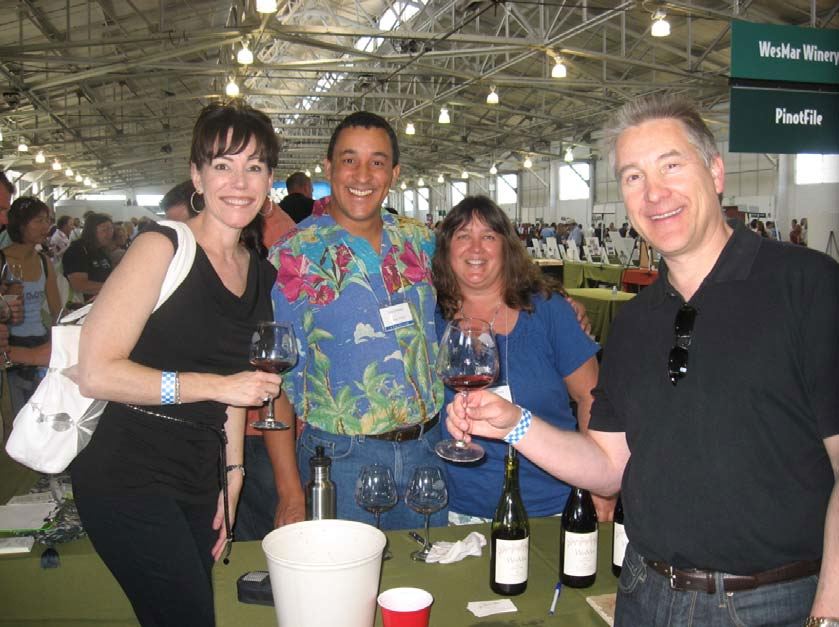 The name, WesMar, pronounced “Wes-Mare,” is a combination of Kirk and Denise’s middle names. There are two very distinctive features of WesMar Pinot Noir. First, is a remarkable consistency from one vintage to the next and one bottle to the next, regardless of vineyard source. There is an uncompromising commitment to quality, a reflection of the fact that Denise and Kirk are control freaks. They go about their work meticulously with tight controls and dedication. I can honestly report that I have been drinking WesMar Pinot for eight years and have never had a bad bottle. In 2008, the Hellenthal Vineyard on the Sonoma Coast was affected by the summer wildfires. When fermentation began, Kirk and Denise discovered an ash and smoky quality permeating the wine. Attempts to mask the flavor through blending were unacceptable. Since they do not filter their wines, they had little choice but to sell all the Hellenthal wine on the bulk market, even though it was their largest production. This reflects their vow of quality and their reluctance to release any wine that does not call them or you back for more. Second, the separate bottlings from each vintage are always unique. Denise remarks, "People tend to gravitate toward that which is familiar. This may be even more true with wines. We all want to replicate the success we have had with a particular vineyard or vintage. To counter this phenomenon, we strive to make wines that have individual personalities but offer very similar levels of richness.” Denise refers to these distinct terroir driven differences as “WesMarrior.” WesMar harkens back to a simpler time in the wine industry when people visited wineries, got to know the owners, and bought their wines directly. At WesMar, there is no effort wasted on a fancy tasting room or an expensive marketing program, yet Kirk and Denise embrace contact with their consumers and warmly receive visitors by appointment to their modest winery. They refuse to sell their wines on the internet, preferring to deal with their customers on a more personal level by written or phone communication. They want customers to call them to order wines, realizing that to know and treasure their wines is to know and talk to them. WesMar owns no vineyards and sources grapes from Russian River Valley and Sonoma Coast vineyards through long-established relationships. Kirk and Denise are developing their modest ranch property in the Russian River Valley and have a vineyard development permit in hand. Soon they will be removing the old apple trees on the property and laying the plans for an estate Pinot Noir vineyard. A unique feature of the winemaking at WesMar is the use of retired rectangular open top milk storage tanks that go back to the early days of Williams Selyem. The tanks allow good access for hand punch downs and better skin to juice extraction due to their generous horizontal rather than vertical dimensions. Because the tanks had internal cooling jackets to keep the milk cold, the tanks can easily be used to control fermentation temperatures using glycol. Whole cluster ranges from 20% to 40%, depending on the vintage and a number of other factors. The goal with whole cluster is to achieve aroma and flavor nuances and age ability, yet preserve early drink ability that most consumers prefer. Fermentations last 7 to 10 days after which pressing is carried out with a vintage incarnated bladder press once used for apples. Aging is carried out in 50% to 70% new Francois Fréres oak barrels for 11 months. The entire winemaking process employs gravity flow as WesMar owns no pumps. Fining and filtration are unnecessary because the wines are lovingly tendered in small lots and constantly monitored for sanitation and stability. No flavor nuances are ever squandered by manipulation or intervention. Asked to describe the WesMar style, Denise touts, “Aromatic, fruit-forward, modest ripeness, balanced acidity, complimentary fruit tannins, subtle oak impressions, rich flavors, finishes with a cloying mouth feel and flavors that linger long after the wine has left the mouth.” In other words, as the winery’s tag line proclaims, “Palate pleasing Pinots.” Traditionally, WesMar has released their wines each year at Valentine’s Day. Because they have found that their wines benefit significantly from additional time in the bottle, they are now releasing their wines in the fall two years after harvest. The 2008 lineup has just been offered. Because of the above mentioned fires, no Sonoma Coast or Hellenthal Vineyard Pinot Noir was released in the 2008 vintage. The lineup does include a Russian River Valley blend of all the vineyard designated wines and three single vineyard Russian River Valley Pinot Noirs from Salzgeber, Balletto, and Oehlman vineyards. Prices are modest at $35-$40 and magnums are available at twice the cost of a 750 ml bottle. Join the mailing list at www.wesmarwinery.com or phone 707-829-8824 to order wines. I have quite a collection of WesMar Pinot Noirs in my cellar and decided to take a look at ten wines from the 2004, 2005 and 2006 vintages to commemorate the winery’s tenth anniversary and see how the wines are progressing. All the wines are moderate in color and some have a very slight haze due to non filtration. The aromatics are appealing and there is no unwelcome intrusion of oak or alcohol. The wines have aged nicely and many will reach ten years easily, although there isn’t much reason to wait on most of the reviewed wines.
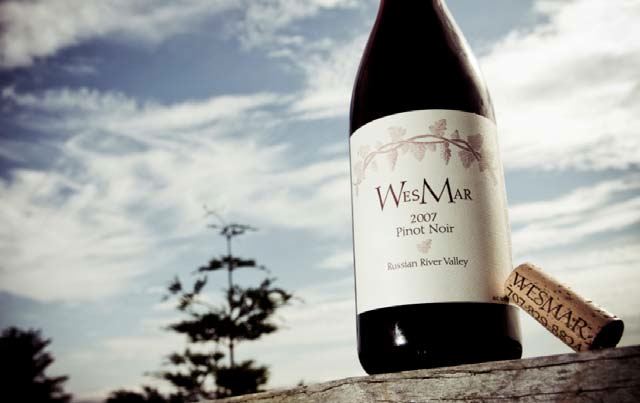
2004 WesMar Russian River Valley Pinot Noir 14.1% alc.,395 cases, $32. · Initially the nose offers scents of black cherries, cherry reduction sauce, dark chocolate, spice, and cut flowers progressing over time to added scents of shoe leather and mushrooms. Slightly roasted in flavor featuring black cherry and dark red berry fruits slathered in maple syrup. Seems to have aged more than the other 2004 Pinot Noirs I tasted and I would drink up. Good.
2004 WesMar Olivet Lane Vineyard Russian River Valley Pinot Noir 14.4% alc., 177 cases, $37. · The aromas are striking initially showing dark berry jam and exotic spices but fadeing in the glass, becoming less fruity and more savory with a slight green note over time. Tasty essence of fresh and juicy dark red berries and cherries with a subtle undertone of oak. Great harmony with fading fine tannins and a fruit-filled finish. Good.
2004 WesMar Balletto Vineyard Sonoma Coast Pinot Noir 14.3% alc., 151 cases, $37. · A brooding nose needs some coaxing in the glass but eventually offers pleasing aromas of dark stone fruits, berry jam, oak and pine pitch. Delicious, intense and persistent on the palate, offering a striking array of Pinot fruits that really grab your attention. Moderately dense, very sappy, and still retaining a healthy tannic backbone. This beauty is ready to go the distance.
2005 WesMar Vintner’s Reserve Russian River Valley Pinot Noir 14.6% alc., 101 cases, $45. · Shy aromas of spiced cherries and forest floor. A masculine wine with mildly aggressive tannins that will stand up to hearty food. A mix of black cherry and berry fruit that takes on more charm with time in the glass. Doesn’t excite now but balance is respectable and worth holding a few more years to see what develops. Good.
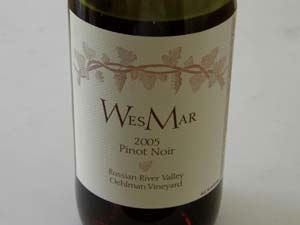 2005 WesMar Oehlman Vineyard Russian River Valley Pinot Noir 14.1% alc., 268 cases, $37. · Moderately light reddish-purple color with a slight haze (unfiltered). Aromatically exciting leading off with a burst of cherries and spice followed over time in the glass with added notes of sage, seasoned oak and sandalwood. Medium-weighted flavors of redtoned cherry and raspberry fruits that explode in the mouth complimented by hints of baking spices with the satisfying melange lingering on the pleasing finish. Silky smooth with fine tannins. Probably at its peak but can hold for a few more years.
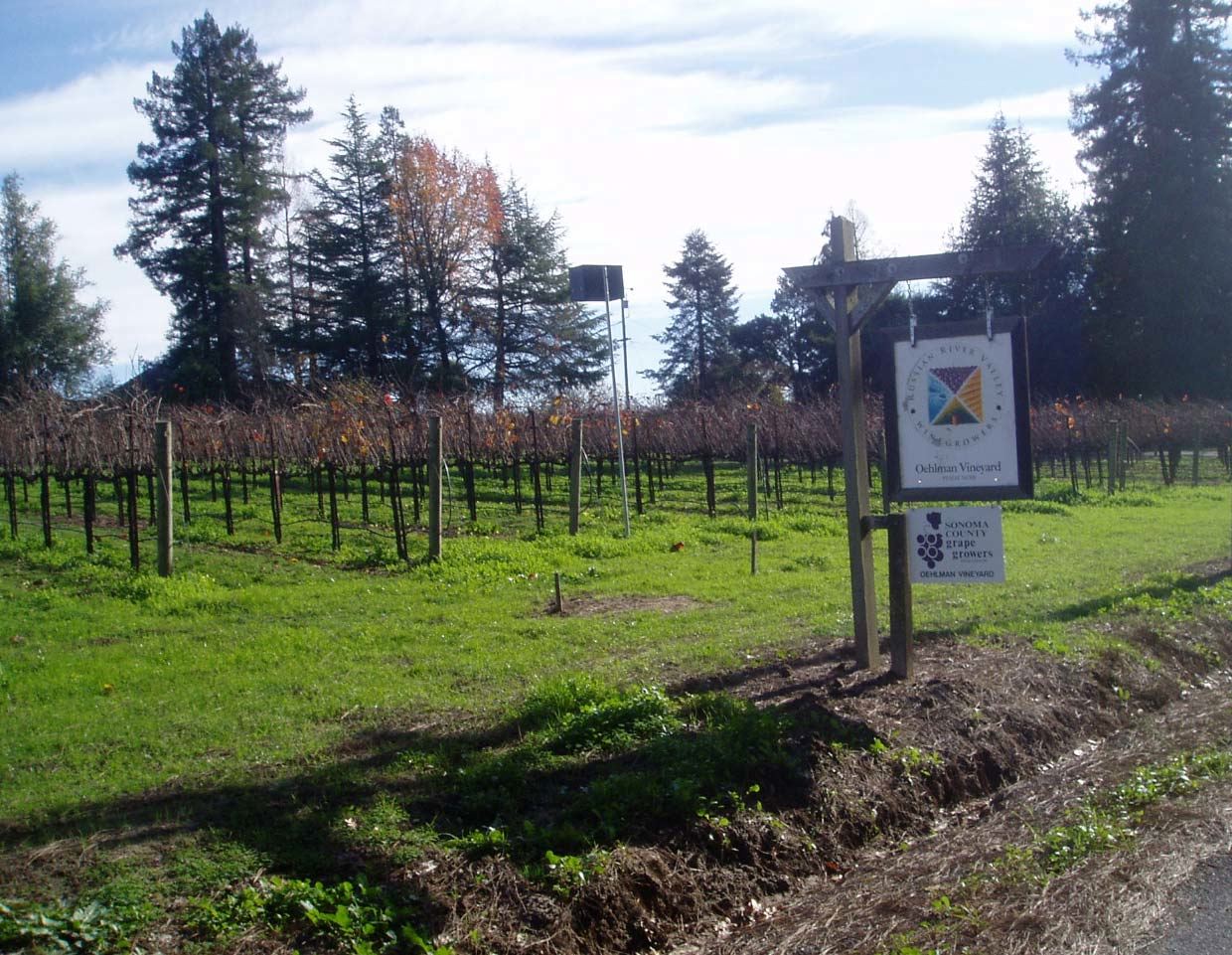
2005 WesMar Balletto Vineyard Sonoma Coast Pinot Noir 14.3% alc., 204 cases, $40. · Darkest of the 2005 lineup. Aromas of darker berries, roasted coffee, anise and oak. Delicious core of darker fruits that are intensely flavored and accented by undertones of cola, smoke and grill marks. A bold wine that has soft grainy tannins and is remarkable for its seamlessness. Drinking beautifully now and should hold several years. Very good.
2005 WesMar Hellenthal Vineyard Sonoma Coast Pinot Noir 14.4% alc., 115 cases, $50. · Lovely exotic scents including berry patch and mushrooms. Loaded with dense, darker fruits including flavors of plum sauce and cassis. Rugged and wild, even showing sauvage and meatiness. I have a love-hate relationship with this vineyard. It always produces a chameleon of a wine that can be rough, rustic and tannic at times, and at other times, charming and seductive. Right now this wine is leaning toward the seductive side. No hurry to drink up, but why wait? Very good.
2006 WesMar Balletto Vineyard Sonoma Coast Pinot Noir 14.5% alc., 291 cases, $40. · Moderate reddishpurple color in the glass. Nuanced aromatics featuring ripe strawberries, dried cherries, currants and lacquered wood. Tasty core of very ripe black cherries with hints of cherry cola, tea and mocha. A bit disjointed now and falls off on the finish. Has the goods to last and I would give this wine a few more years in the cellar. Good.
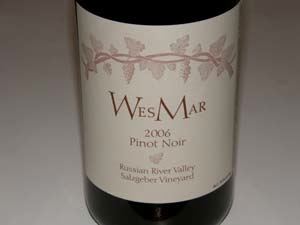 2006 WesMar Salzgeber Vineyard Russian River Valley Pinot Noir 14.5% alc., 157 cases, $40. · Great nose. Vivid scents of fresh berry pie with a hint of baking spices including cinnamon. Delicious cherry and red berry core that really clings to the palate and lingers. A striking wine that has plenty of t ‘n a and the impeccable balance to last. Holds up beautifully over time in the glass. Russian River Valley Pinot at its finest. Even better later in the day from an opened bottle (my wife and I polished it off at dinner).
2006 WesMar Oehlman Vineyard Russian River Valley Pinot Noir 14.6% alc., 261 cases, $37. · Aromas of wooded forest, green garden and jam on toast. Enticing core of Bing cherries, red berries and cranberries with a hint of green herbs. Discreetly intense with the structure to last. Beautifully composed but not offering all of its charms yet. Still a Lolita and needs more time in the cellar. Very good.
Pinot Briefs
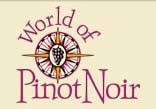 2011 World of Pinot Noir Tickets for the World of Pinot Noir, March 4-6, 2011, went on sale on October 1. Interesting seminars include a discussion of alcohol and balance, a study of Hirsch Vineyard, and a vintage Burgundy tasting. The featured tasting on Saturday, moderated by Allen Meadows, is titled, “Young Turks of Burgundy.” A new dinner extravaganza has been added Friday night at Chamisal Vineyards as well as a Sunday brunch walk-around tasting at The Cliffs Resort. The event is always a sell out and lodging should be secured early. Visit www.wopn.com for information and tickets. Snooth Wine Pro A new iPhone application uses innovative image recognition technology, allowing you to take a photo of a wine label and automatically match it to Snooth’s database of over a million wines. Once a match is made you can view stores closest to you that have the wine in stock, compare prices, buy the wine online through the Snooth retail network, read expert and user reviews and browse for similar wines by winery, region or varietal. Snooth Wine Pro is available in the iTunes App Store for $4.99. Users can also install Snooth Wine, a free, ad-supported version. For more information and screenshots, visit www.snooth.com/ iphone-app. Rivers-Marie Acquires Summa Vineyard Thomas and Genevieve Brown, proprietors of Rivers- Marie wines, have bought the iconic Summa Vineyard on the Sonoma Coast. Dutton-Goldfield Releases 2008 Devil’s Gulch Pinot Noir This is a very special bottling from Mark Pasternak’s Devil’s Gulch Vineyard in Marin County. In 2008, the weather was warm with unusually low humidity during the harvest season, and this coldest and wettest of Dutton-Goldfield’s Pinot ranches performed beautifully. The clusters were black, tiny and concentrated, producing a wine with striking density, lushness and concentration. This is a wine I buy for my cellar every year. 535 cases produced, $58 per bottle. Dan Goldfield was a featured speaker at this year’s International Pinot Noir Celebration. Visit www.duttongoldfield.com. For those looking for a different white, check out Dutton-Goldfield’s outstanding Shop Block Pinot Blanc and Green Valley Gewurztraminer. Bonterra Vineyards Adds Pinot Noir to Portfolio Bonterra is the number one producer of California wine made from organically grown grapes. The winery is introducing a 2009 Pinot Noir ($19.99) sourced from Mendocino County and Anderson Valley crafted from 100% organic grapes by winemaker Robert Blue. Bonterra wines are produced in Mendocino County and marketed and produced by Brown-Forman Corporation. Visit www.bonterra.com. I hope to review this wine soon when it is released. Wine Labeling Bill Signed Into Law AB1798, the conjunctive wine label initiative, was signed into law by Governor Schwarzenegger on September 24, 2010. Wineries must now include Sonoma County on their labels for all wines produced in Sonoma County or one of its 13 AVAs, along with the AVA, when the law becomes effective January 1, 2011. Vintners will have three years to phase in the changes to their labels. Sonoma County vintners and winegrowers hope that this will build a stronger Sonoma County brand. Outlook Not Good for High End Pinots A survey taken at the recent 19th Annual Wine Industry Financial Symposium and reported at www.pressdemocrat.com, indicated that consumers are looking closely at value and many in attendance at the symposium predict that over $50 wines will take at least five to ten years or even longer to come back. Winery owners are more optimistic than winegrowers. PinotFile a Great Resource Did you realize that the PinotFile contains profiles for 1,261 producers of Pinot Noir, 3,650 tasting notes on Pinot Noir and Chardonnay wines, and 103 tag lines about Pinot Noir? The PinotFile has 942 articles primarily on Pinot Noir and 80 audio recordings on Pinot Noir-related subjects of interest. Links are provided to podcasts on Grape Radio in which the Prince has participated. The Pinot Trail Travel Directory contains recommendations for wineries to visit, lodging, picnic supplies, restaurants, and travel related appellation websites for all the major wine regions of California and the Willamette Valley of Oregon. A complete listing of annual Pinot Noir festivals in Oregon and California is included in the Pinot Trail Travel section as well. You can also contact the Prince with questions (prince@princeofpinot.com).
Pinoiriste Syndrome
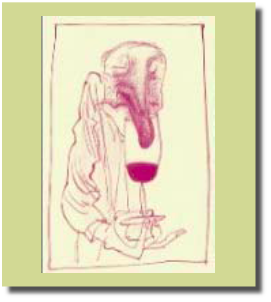 Friends have lamented that once I introduce them to great Pinot Noir, they lose interest in drinking other wines. Once their heart pounds over a premium California Pinot Noir or their psyche is enthralled with a Vosne- Romanee, they are hooked. Everything else pales in comparison. These lucky, but confused individuals are suffering from what I have termed the “Pinoiriste Syndrome.” This syndrome is closely related to the “Gourmand Syndrome,” first described by Marianne Regord PhD of Zurich and Theodoc Landis MD of Geneva in a medical report titled, “Gourmand Syndrome: Eating Passion Associated with Right Anterior Lesions.” The syndrome is defined as a newly acquired craving for high quality food with an onset dating to an injury, tumor or hemorrhage of the right frontal brain region. This site in the brain is where both the olfactory system and our emotional center are located, and where a number of addictive behaviors originate. I have postulated that a strikingly good Pinot Noir significantly modifies the physiological and psychological nerve functions in the anterior frontal brain, causing a hopeless addiction to fine Pinot Noir. Far-fetched you say? Tannins in Pinot Noir combine with starches during digestion to produce serotonin. Altered serotonin levels in the brain may produce a euphoric buzz. Although Pinot Noir is far from the most tannic wine, its tannins seem to have more of a brain-altering influence. Histamine and tyramine, which are present in Pinot Noir in small amounts, have the effect of dilating blood vessels and increasing the systemic and psychological effect of euphoria. The pheromones of the Pinot Noir grape are very closely related to male pheromones. All the aromas in the Pinot Noir grape such as spice, musk, earth and barnyard are associated with the principal male smell, andosterone. Truffles, vanilla and oaky smells of Pinot Noir aged in oak barrels are also andosterone-like. These smells open the door to desire. Complications of the Pinoiriste Syndrome including a hoarding instinct. When a sufferer finds an ephemeral Pinot Noir, he will not share it with others and will attempt to hoard it in his cellar. He may put aside his Bible and instead religiously read the PinotFile. To the pinoiriste, Pinot Noir becomes more of a religion than a grape. When out socially with friends, pinoiristes may begin to throw out phrases like, “Texture of Persian silk,” or “Like beef stew on a bed of roses,” or “Enough t (tannin) and a (acid) to fill a chorus line.” Wine cognoscenti are seeing an epidemic of Pinoiriste Syndrome. Once the mystique of Pinot Noir has taken hold, the sufferers are constantly searching for that tantalizing experience, always dreaming of that jammy strawberry fragrance, that voluptuous mouth feel, the concentrated cherry flavors, and the exquisite finesse. As Canadian writer Konrad Ejbich said, “It is heaven in a glass, smelling like great sex and tasting like the ripest strawberries, raspberries and black cherries all at once.” Further research is ongoing, but not very seriously, because who really wants a cure? |